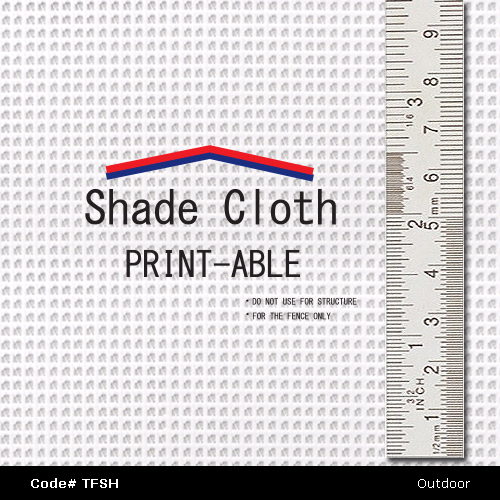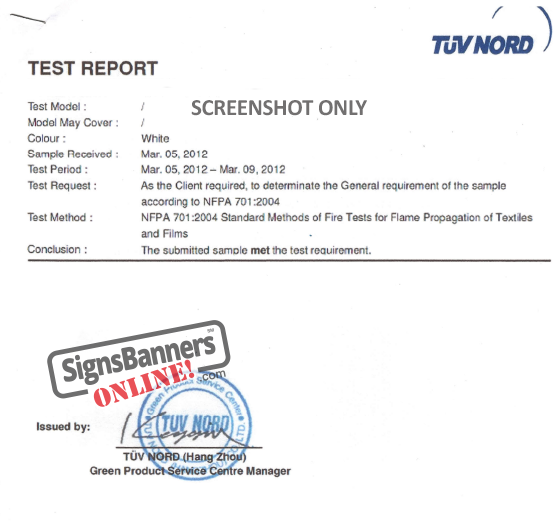| Temporary Fence Material | |
|---|---|
| Max Print Width: | 1560mm 5'5"ft |
| Finish: | Smooth white. |
| Weight: | 305 gsm / 16 oz |
| Coating: | Double Coated PVC 220micron |
| Structure: | 280Dx280D Inner Woven Membrane |
| Flamability: | Flame Retardant Din-4012-B1 USA NFPA 701. Small scale. |
| Durability: | Outdoor 12-36 mth. |
| Recycle: | 100% Recycle. |
< See Product Page
Note: Outdoor application. UV protected
Page Link | See How others are using this product here.
Commonly used for outdoor site and civil situations.

Features
- Large outdoor
- Semi-sheen
- Full Graphic capability
- Logo and Photographic excellence
- Genuine print receptive coating
- Most finish & fitting options available
- Dust control screening
- UV Stabilized
Shade cloth with a matt surface tiny honeycomb holes that offer suitable print receptive mesh screen products as used for temporary fencing panels. Set a reasonable 305 gsm 16 oz it is lightweight super strong and ideal for well secured temporary fencing and site dust control as now demanded by many counties and local regulations for contractor works.
NOTE: The printable shade cloth range is a 'cover material only'. It is not a safety fall product.
Storage Handling Transport
No special handling requirements. Wear PPE. No special storage requirements. Transport: US DOT Hazard Class: Not regulated. IATA/IMDG/RID/ADR/UN(not regulated/not classified). TDG (Canada) Foreign Inventory Status: AU(ACIS) CA(DSL) China(IECSC) PI(PICCS) EU(EINECS/ELINCS/NLPL) JP(ENCS) KR(KECI) NZ. PVC VINYL is not classified as a hazardous substance.
Health Hazards
Skin-Eyes: May cause mechanical irritation. Exposure Guidelines: Protect against hazards such as contact with high speed yarn. Eyewear: Safety glasses during processing. Inhalation: Not respirable in this form. Respiratory: An approved dust respirator should be worn. Ventilation: Thermal processing requires ventialtion of fumes and vapors which may cause irritation to the nose and throat. Ingestion: Not a probable route of exposure. Chronic. Experimental carcinogen. Chronic inhalation of dust can cause pulmonary damage, blood effects, and abnormal liver function.
Properties
Ingredient Name: Poly(vinyl chloride), high molecuar weight. CAS Number 9002-86-2. Weight% >100. EINECS 206-625-7 Produced acc. to EN ISO No Heavy metals, PVC resins, phthalates of fungicides. Recyclable. No carcinogen properties listed. Appearance: Off-white solid or delustered fiber or clear to greenish resin. Physical State: Solid. Odor: Ink after printing. Solubility In Water: Insoluble. Incompatabilities: Normally Stable, Tends to dissolve in caustic materials.
Hazards
Hazard Symbols: None. Hazardous Decomposition Products: Chemical Stability: Reacts violently with F2. Ordinary temperatures sause slow dehalogenation producing hydrogen chloride. Conditions to avoid: Incompatible materials, dust generation, excess heat, strong oxidizing agents. Hazardous Polymerization: May occur. Toxicological Information: Not considered to cause irritant or allergic contact dematitis. Delayed: None shown. Disposal Considerations: Dispose in a manner consistent with federal, state and local regulations: No. Other Disposal Considerations: (hazardous decomposition products) Hydrogen chloride, phosgene, carbon monoxide, carbon dioxide. Toxic Substance Control Act (TSCA): Polymer is listed on the TSCA Inventory. RTECS CAS#9002-86-2:KV0350000.
Declaration of the preparation:
- The preparation isn't classified as dangerous and it contains no hazardous material.
- Manufactured to meet NFPA-701 Small Scale
Hazards Identification: None reported or known to exist. FIRST AID MEASURE [Acute-Chronic None listed] Ingestion: Seek immediate medical assistance.
Material Identification:
- Poly Ethylenet Terephthlate
- Poly Vinyl Chloride
- Di Iso Nonyl Phthalate
- Calcium Carbonate
- Barium zinc Organic Coplex
- Titanium Dioxide
FIRE: Flame Retardant Din-4012-B1 USA NFPA 701. Draperies used in public spaces. Test Method: DIN4102-1: Name of Product: PVC BANNER (suitable test) Conclusion: When tested as specified, the test results of the submitted samples not exceed the requirement of DIN4102.

Fire Fighting Flammable Limits In Air: NA. Fire Fighting Media: Standard Agents, Dry Chemical Foam, CO2, Water, Spray (fog). Fire Fighting Equipment: Wear full bunker including self contain breathing apparatus to avoid exposure to smoke and vapors. Unusual Fire And Explosion Hazards: NA. Physical & Chemical Properties: Melting point 250°C. Decomposition Temperature: >350°C. Conditions To Avoid: Temperatures above 350°C will cause decompositions in the presence of oxygen. Solubility In Water: Neglible. Chemical Stability: Stable. Incompatability: Incompatible or can react with strong oxidizers, bases and acids.
Material Fibers are coated with minor quantities of finish oils. Textile processes may volatilize portions of these finishes and produce visible misting in the workplace. Ventilation is recommended to minimize exposure to such finish mists which should not exceed a concentration of 5 mg/m3 ACGIH TLV for mineral oil.
SBO does not warrant banner materials for the following: Seamed in order to make a large banner. Ripping, tearing or damage due to the effects of the weather or environment or installation.
Maintenance: Use water for cleaning printed surfaces. The cleaner must be wet, non abrasive and without solvents or alcohol. (Solvent and alcohol can damage the banner material and printed images.) The cleaner must not be either strongly acidic or alkaline (pH value 3.0~11.0)
Tension: Do not apply tension to the banner. Too much tension may damage the material; therefore keep the tension under 7kgf.
PVC VINYL banners are/maybe coated with ink. Textile printing processes may volatilize portions of these finishes. The inkjet ink prepartion isn't classified as dangerous and it contains no hazardous material after curing during normal handling and operation. At tempertures between approximately 130-190°C the applied finish may evaporate or decompose. Residual solvents post 128 hours: 0.05%.
The information in this Material Data Sheet page relates only to the specific material designated and may not apply where such material is used in combination with any other material or in any process. This information is to the best of our knowledge based on accurate and reliable information, but may be subject to revision as new information becomes available. However, no representation, warranty or guarantee is made as to its accuracy, reliability or completeness. Each user is responsible for satisfying itself as to the suitability of such information for its own particular use; therefore additional safety precautions may be required. E&EO.